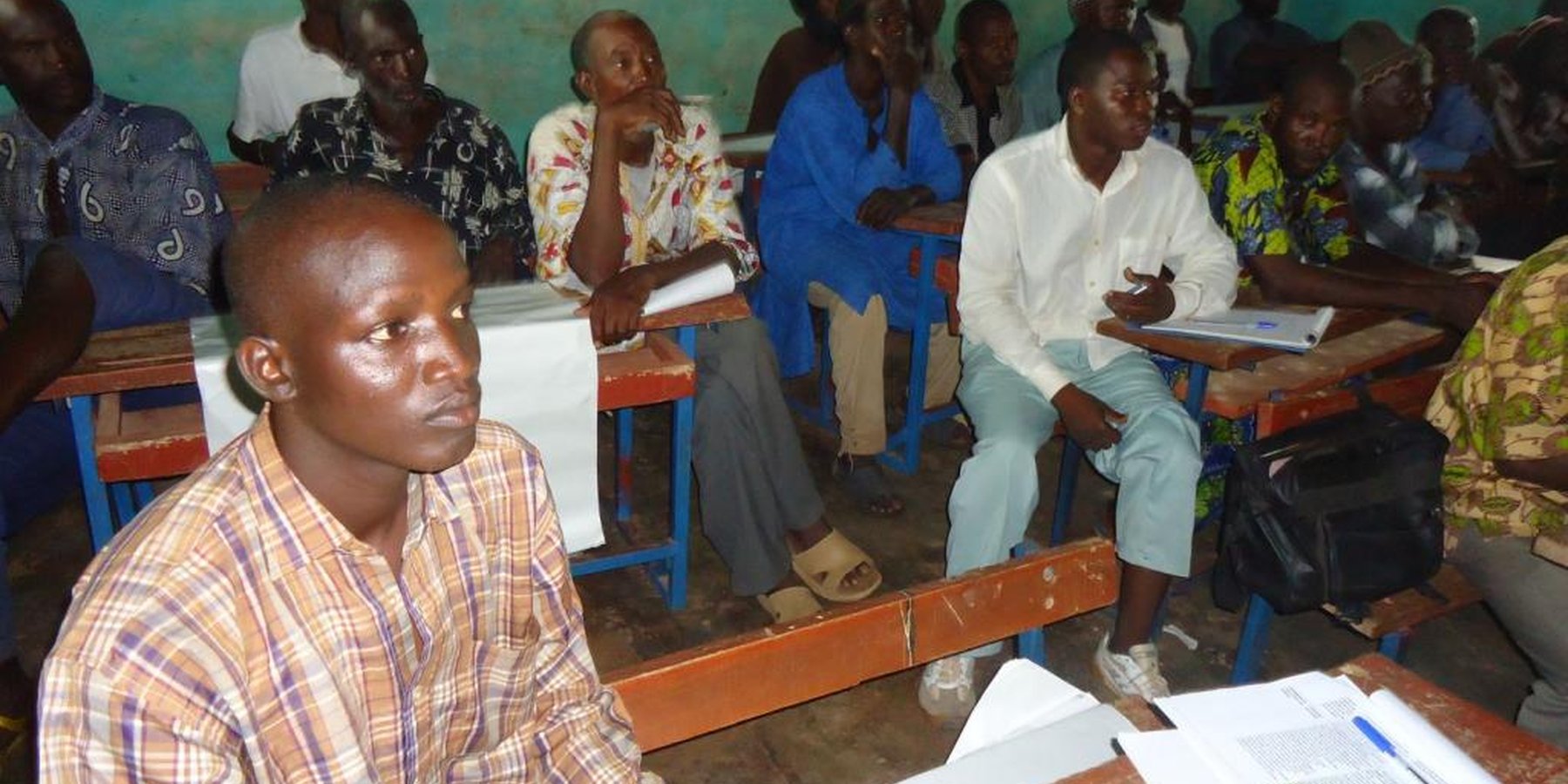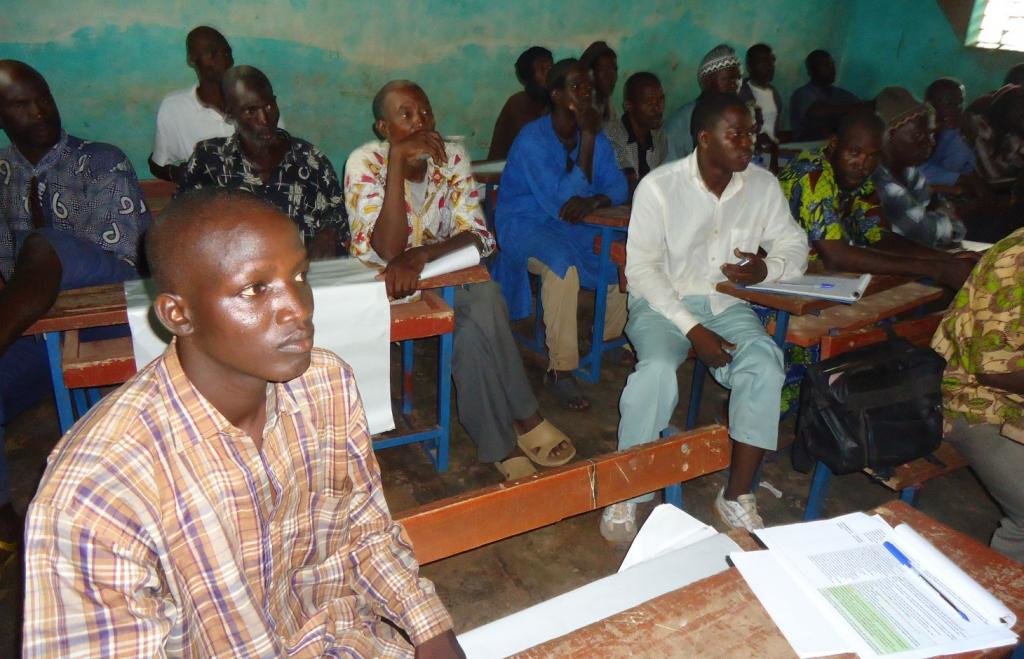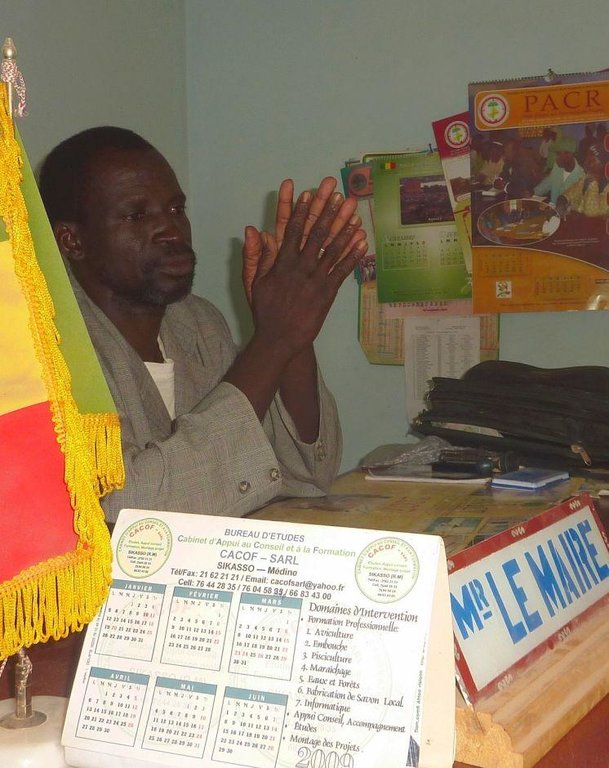Identifying and prioritizing scheme sites using a territorial, multi-stakeholder approach [Мали]
- Шинийг нээх:
- Шинэчлэх:
- Эмхэтгэгч: Dieter Nill
- Хянан тохиолдуулагч: –
- Хянагч: Laura Ebneter
Identification et priorisation des sites d’aménagement dans une approche territoriale multi-acteurs (French)
approaches_2499 - Мали
Бүлгүүдийг үзэх
Бүгдийг дэлгэх Бүгдийг хаах1. Ерөнхий мэдээлэл
1.2 Арга барилыг баримтжуулах болон үнэлгээ хийхэд оролцсон хүн эсвэл байгууллагын холбоо барих хаяг
ГТМ мэргэжилтэн:
Diallo Safiatou
safiatou.diallo@helvetas.org
Helvetas - Swiss Intercooperation
Мали
Арга барилыг баримтжуулах/үнэлэх ажилд дэмжлэг үзүүлсэн байгууллага(ууд)-ын нэр (шаардлагатай бол)
HELVETAS (Swiss Intercooperation)Арга барилыг баримтжуулах/үнэлэх ажилд дэмжлэг үзүүлсэн байгууллага(ууд)-ын нэр (шаардлагатай бол)
Deutsche Gesellschaft für Internationale Zusammenarbeit (GIZ) GmbH (GIZ) - Герман1.3 WOCAT-аар баримтжуулсан өгөгдлийг ашиглахтай холбоотой нөхцөл
Мэдээллийг хэзээ (газар дээр нь) цуглуулсан бэ?
01/07/2012
Эмхэтгэгч болон гол мэдээлэгч хүн(хүмүүс) WOCAT аргачлалаар баримтжуулсан мэдээллийг ашиглахтай холбоотой нөхцлийг хүлээн зөвшөөрсөн:
Тийм
2. ГТМ Арга барилын тодорхойлолт
2.1 Арга барилын товч тодорхойлолт
The desired objectives are to identify the priority actions for investment that have been agreed by local actors within the framework of the pastoral scheme, and to develop lowland areas.
2.2 Арга барилын дэлгэрэнгүй тодорхойлолт
Арга барилын дэлгэрэнгүй тодорхойлолт:
The approach aims (i) to ensure that all actors involved in developing lowland areas participate in the planning process and (ii) to prepare the ground for the self-management of the lowland scheme from the outset of the process. The goal is to gear the identification and prioritisation processes for schemes being carried out by local authorities (regional council, intermunicipal body, circle) towards the actual needs of local people.
This is achieved by preparing actors and organising multi-stakeholder meetings so that the visions of the different parties can be aligned in an inclusive way. This joint approach ensures investments are more relevant and well founded.
This practice was implemented in the four circles participating the AVAL programme: Kadiolo,
Sikasso, Yorosso and Koutiala. The practice led to the identification of around 10 priority investment sites in each of the four circles concerned. The sites are agricultural (dams, ponds) or pastoral (rangeland, cattle market, route marking). At the beginning of the process, the terms of reference (ToR) and data collection sheets are drawn up and presented to all the actors to ensure they are equally informed and to demonstrate the relevance of the approach across the regional council. The first workshop promotes a common understanding of the objectives and outcomes of the good practice.
Data on actual investment needs is collected by the commune (using data collection sheets) from actors in each village. An initial proposal for the identification and prioritisation criteria for scheme sites is put together by the regional council and its staff. The criteria are submitted for the approval of local actors in forums organised at the circle level with the support of the technical services. Following a first sift based on predefined criteria, the select committee judges the commitments and budgets of each and allocates scores for each criteria ranging from zero to five. Compulsory criteria (initial selection stage): 1)Absence of land ownership disputes, 2)Membership of PDESC, 3)Opening up the area – distance to a road or track that is accessible in all seasons, 4)The number of beneficiaries, 5)Farming of lowland areas–area of farmed land in relation to the possible farmable area. Optional criteria (second-stage sift for projects that have cleared the initial stage): 1)Diversification–number of products or farms, 2)Gender–number of women in relation to men, 3)Capacity of actors to contribute. On this basis, the actors from each circle identify the sites that offer the greatest potential from among the development projects undertaken by communes in the area in the context of their development programmes. Local authorities are then tasked with ensuring the supervision of the development process and the management of works and developed land. At the prioritisation workshop, each commune in the circle takes turn presenting and making the case for its completed data sheet to the plenary.
The regional council initiates the process, defines the identification and prioritisation criteria, undertakes the regional consolidation of projects for delivery at the local level and acts as mediator between communities.
The circle councils organise the information and consultation workshops and the decision-making/prioritisation workshop, and they set up the moderation team with the support of technical services.
Communes pre-select projects at the commune level, assessing them in terms of their relevance to PDESC and the criteria put forward; they ensure data collection sheets are completed in collaboration with beneficiaries, and they take part in the prioritisation process by making the case for their projects.
The support structure (AVAL) provides training and advisory support to actors.
Technical services provide technical support and make sure activities are coherent and in line with national programmes. Consultants facilitate the process and train the actors.
2.3 Арга барилын зурагууд
2.5 Арга барил нэвтрүүлсэн улс орон / бүс нутаг / байршил
Улс:
Мали
Улс/аймаг/сум:
Mali
Байршлын дэлгэрэнгүй тодорхойлолт:
Kadiolo, Sikasso, Yorosso, Koutiala
2.6 Арга барилыг эхлэх, дуусах огноо
Эхлэх жилийг тэмдэглэ:
2009
2.7 Арга барилын төрөл
- төсөл / хөтөлбөр дээр үндэслэсэн
2.8 Арга барилын үндсэн зорилго, зорилтууд
The Approach focused mainly on SLM with other activities
The approach aims (i) to ensure that all actors involved in developing lowland areas participate in the planning process and (ii) to prepare the ground for the self-management of the lowland scheme from the outset of the process. The goal is to gear the identification and prioritisation processes for schemes being carried out by local authorities (regional council, intermunicipal body, circle) towards the actual needs of local people.
The SLM Approach addressed the following problems: lack of involvement of stakeholders in developing lowland areas
2.9 Арга барилын хүрээнд хэрэгжсэн Технологи/Технологиудад дэмжсэн эсвэл саад учруулсан нөхцлүүд
Бүтэц зохион байгуулалт
- Хазаарлалт
lack of involvement of stakeholders in developing lowland areas
Treatment through the SLM Approach: all actors involved in developing lowland areas participate in the planning process
3. Оролцогч талуудын оролцоо ба үүргүүд
3.1 Арга барилд оролцогч талууд болон тэдгээрийн үүргүүд
- Орон нутгийн газар ашиглагч / орон нутгийн иргэд
- ГТМ-ийн мэргэжилтэн/ хөдөө аж ахуйн зөвлөх
- ТББ
HELVETAS - Swiss Intercooperation
- Засгийн газар (шийдвэр гаргагч, төлөвлөгч)
3.2 Арга барилын янз бүрийн үе шатанд орон нутгийн газар ашиглагчид / бүлэглэлүүдийг татан оролцуулах
| Орон нутгийн газар ашиглагч / орон нутгийн иргэдийн оролцоо | Хэн оролцсоныг тодорхойлж, үйл ажиллагааг тайлбарлана уу | |
|---|---|---|
| санаачлага/идэвхжүүлэлт | идэвхигүй | |
| Төлөвлөгөө | интерактив | |
| Хэрэгжилт | интерактив | |
| Мониторинг/ үнэлгээ | идэвхигүй | |
| Research | идэвхигүй |
3.4 ГТМ-ийн технологи/технологиуд сонгох шийдвэр
Хэрэгжүүлэх Технологи/Технологиудын сонголтыг хийж шийдвэр гаргасан хүнийг тодорхойлно уу:
- голдуу ГТМ-ийн мэргэжилтнүүд, газар ашиглагчидтай зөвлөлдсөний үндсэн дээр
Тайлбар:
Decisions on the method of implementing the SLM Technology were made by mainly by SLM specialists with consultation of land users
4. Техникийн дэмжлэг, чадавхи бүрдүүлэх, мэдлэгийн менежмент
4.1 Чадавхи бэхжүүлэх/сургалт
Газар эзэмшигчид / бусад оролцогч талуудад сургалт явуулсан уу?
Тийм
Хэн сургалтанд хамрагдсан бэ:
- Газар ашиглагчид
Сургалтын хэлбэр:
- Олон нийтийн уулзалт
4.2 Зөвлөх үйлчилгээ
Газар ашиглагчдад зөвлөх үйлчилгээ авах боломжтой байдаг уу?
Тийм
Зөвлөх үйлчилгээ үзүүлсэн эсэхийг тогтоо:
- Тогтмол төвд
Тодорхойлолт / тайлбар:
Advisory service is quite adequate to ensure the continuation of land conservation activities; The planning capacity of local authorities is strengthened, and this expertise in the planning process can be applied to other sectors
4.3 Институцийг бэхжүүлэх (байгууллагын хөгжил)
Арга барилаар дамжуулан институц байгуулагдаж эсвэл бэхжсэн үү?
- Тийм, маш их
Байгууллагууд бэхжиж, үүсэн бий болсон түвшин(үүд)-г тодорхойлно уу:
- Орон нутгийн
Дэмжлэгийн төрлийг ялга:
- чадавхи бэхжүүлэх / сургалт
4.4 Мониторинг ба үнэлгээ
Мониторинг болон үнэлгээ нь арга барилын хэсэг үү?
Тийм
Тайлбар:
socio-cultural aspects were ad hoc monitored by project staff through observations;
economic / production aspects were ad hoc monitored by project staff through observations
management of Approach aspects were ad hoc monitored by project staff through observations
There were no changes in the Approach as a result of monitoring and evaluation
There were no changes in the Technology as a result of monitoring and evaluation
4.5 Судалгаа
Судалгаа арга барилын хэсэг нь байсан уу?
Тийм
Сэдвийг тодруулна уу:
- Социологи
- Эдийн засаг/ зах зээл
- Технологи
5. Санхүүгийн болон гадаад материаллаг дэмжлэг
5.1 ГТМ-ийн Арга барилын бүрэлдэхүүн хэсгийн жилийн төсөв
Хэрэв жилийн төсөв тодорхойгүй бол хягаарыг тодруулна уу:
- 2,000-10,000
Тайлбар (жнь: санхүүжилтийн гол эх үүсвэр / гол хандивлагчид):
Approach costs were met by the following donors: international non-government: 100.0%
5.2 Газар ашиглагчдад санхүүгийн / материаллаг дэмжлэг үзүүлсэн
Технологи / технологийг хэрэгжүүлэхэд газар ашиглагчид санхүүгийн / материаллаг дэмжлэг авсан уу?
Үгүй
5.3 Тодорхой зардлыг даахад чиглэсэн дэмжлэгт (хөдөлмөрийн хүчийг оролцуулаад)
- үгүй
Хэрэв газар ашиглагчийн хөдөлмөрийн хүч чухал байсан бол энэ нь аль хэлбэр байсан:
- сайн дурын
5.4 Кредит
Арга барилын хүрээнд ГТМ-ийн үйл ажиллагаанд зориулж зээлд хамрагдсан уу?
Үгүй
6. Нөлөөллийн дүн шинжилгээ ба дүгнэлт
6.1 Арга барилын нөлөөллүүд
Арга барил нь ГТМ-ийн технологийг хэрэгжүүлж, хадгалахад газар ашиглагчдад тусласан уу?
- Үгүй
- Тийм, бага зэрэг
- Тийм, зарим
- Тийм, их
The planning capacity of local authorities is strengthened, and this expertise in the planning process can be applied to other sectors. Strong levels of community engagement are seen to arise. Investment decisions and funding awards are not carried out in secret deliberations or project offices. The links between the different levels in local authorities are reinforced and a shared development vision is jointly owned by all actors.
Арга барил нь эмзэг бүлгийнхнийг нийгэм, эдийн засгийн хувьд чадавхижуулсан уу?
- Үгүй
- Тийм, бага зэрэг
- Тийм, зарим
- Тийм, их
Did other land users / projects adopt the Approach?
- Үгүй
- Тийм, бага зэрэг
- Тийм, зарим
- Тийм, их
This practice was implemented in the four circles participating the AVAL programme: Kadiolo, Sikasso, Yorosso and Koutiala. The practice led to the identification of around 10 priority investment sites in each of the four circles concerned. The sites are agricultural (dams, ponds) or pastoral (rangeland, cattle market, route marking).
Did the Approach lead to improved livelihoods / human well-being?
- Үгүй
- Тийм, бага зэрэг
- Тийм, зарим
- Тийм, их
Did the Approach help to alleviate poverty?
- Үгүй
- Тийм, бага зэрэг
- Тийм, зарим
- Тийм, их
6.2 ГТМ-ийг хэрэгжүүлэх газар ашиглагчидын гол санаачилга
- үйлдвэрлэл нэмэгдсэн
- Ашиг нэмэгдсэн (боломж), зардал-үр ашгийн харьцаа сайжирсан
- improvement of well-being and livelihoods
6.3 Арга барилын үйл ажиллагааны тогтвортой байдал
Газар ашиглагчид арга барилаар дамжуулан хэрэгжүүлсэн арга хэмжээг тогтвортой хадгалж чадах уу (гадны дэмжлэггүйгээр)?
- Тийм
6.4 Арга барилын тогтвортой/давуу тал/боломжууд
| Эмхэтгэгч, бусад мэдээлэл өгсөн хүмүүсийн өнцгөөс тодорхойлсон давуу тал/боломжууд |
|---|
| The links between the different levels in local authorities are reinforced and a shared development vision is jointly owned by all actors. Each actor comes to understand their importance as part of the implementation of the investment programme. Moreover, strong levels of community engagement are seen to arise. Investment decisions and funding awards are not carried out in secret deliberations or project offices. |
| The moderate costs also help towards making this practice sustainable. |
|
The planning capacity of local authorities is strengthened, and this expertise in the planning process can be applied to other sectors. The inclusive approach and the local availability of facilitation skills are factors that make the practice sustainable. When outcomes are accepted by all actors, the uptake and sustainability of the practice become more likely. (How to sustain/ enhance this strength: It is essential to prepare thoroughly before beginning work: criteria must be clear and relevant; communes must describe and document their scheme propositions and back them up with appropriate arguments; and moderation teams must be objective. Ensuring actors are informed is a major factor for success: all parties have the right to timely information. Elected representatives must have a good understanding of their roles within the context of decentralisation and rural sector development; communities must be closely involved in the process. Inclusive participation requires the involvement of actors across the board. ) |
6.5 Арга барилын дутагдалтай/сул тал/аюул болон тэдгээрийн хэрхэн даван туулах арга замууд
| Эмхэтгэгч, бусад мэдээлэл өгсөн хүмүүсийн өнцгөөс тодорхойлсон сул тал/ дутагдал/ эрсдэл | Тэдгээрийг хэрхэн даван туулах вэ? |
|---|---|
| A major constraint in delivering this practice is the requirement that territorial communities contribute their own funds, as this forms part of the selection criteria |
7. Суурь мэдээлэл болон холбоосууд
7.1 Мэдээллийн эх үүсвэр/аргууд
- Хээрийн уулзалт, судалгаа
- Газар ашиглагчтай хийсэн ярилцлага
7.2 Холбогдох бүтээлийн ишлэл
Гарчиг, зохиогч, он, ISBN:
Manual of Good Practices in Small Scale Irrigation in the Sahel. Experiences from Mali. Published by GIZ in 2014.
Хаанаас авч болох вэ? Зардал?
http://star-www.giz.de/starweb/giz/pub/servlet.starweb
Гарчиг, зохиогч, он, ISBN:
HELVETAS Swiss Intercooperation (2009), Rapport du forum de priorisation des investissements hydro-agricoles et pastoraux. [Report of the hydro-agricultural and pastoral investment prioritisation forum]
Гарчиг, зохиогч, он, ISBN:
HELVETAS Swiss Intercooperation (2010), Convention du partenariat local des cercles de Kadiolo, Sikasso, Koutiala, Yorosso. [Local partnership agreement between the Kadiolo, Sikasso, Koutiala and Yorosso circles]
Холбоос ба модулууд
Бүгдийг дэлгэх Бүгдийг хаахХолбоосууд
Холбоос байхгүй байна
Модулууд
Модуль байхгүй байна




